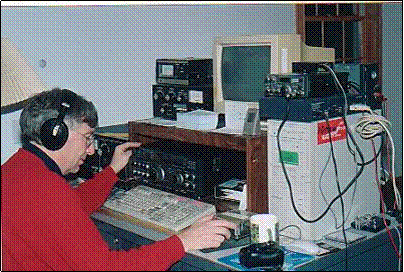
|
Hams use a receiver and a transmitter usually combined into one device called a transceiver. It is connected into a separate power supply unit, an antenna, a speaker and a microphone.
The most important part of the equipment is the antenna. This is connected to the radio transceiver by a cable that carries the radio signal energy.
Many years ago, equipment was very large, often filling a room. Today, some radio transceivers can fit inside a pocket book.
Another piece of equipment is the control unit for antenna. The antenna is mounted on a big motor, which can be turned to a point in whatever direction you choose. The control unit has a scale which shows the compass direction from North to East, South, West and then back to North. A long cable from the control box to the motor allows the motor to be turned on and off remotely.
Above is a photo of our class friend, Dr. Martin Bayes, and his equipment. The unit in the center is the main radio. On the left is an amplifier used to boost the transmitter power level. On the top is the computer he uses to keep records of the contacts he makes. How many contacts do you think Dr. Bayes has made in the past 30 years*? ©Natasha Bochkov, M.C.S., Martin Bayes, Ph.D., and Donna LaRoche M.Ed
(Answer: *Dr. Bayes has made about 66,000 contacts from the United States and another 10,000 from other countries.) |
